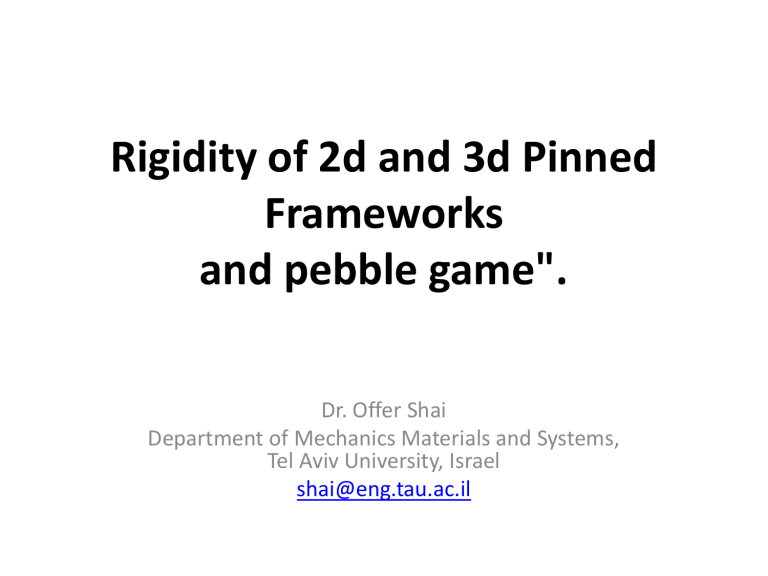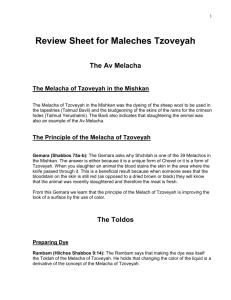Rigidity of 2d and 3d Pinned Frameworks

Rigidity of 2d and 3d Pinned
Frameworks and pebble game".
Dr. Offer Shai
Department of Mechanics Materials and Systems,
Tel Aviv University, Israel shai@eng.tau.ac.il
Rigidity
Theory
Pebble game
Mechanical
Engineering
Theorems and methods in Engineering
In this talk:
Theorems in engineering underlying rigidity circuits .
Methods for check rigidity of Pinned Frameworks from engineering.
Pebble Game and Pinned Frameworks
Framework
Pinned Framework used in engineering
• Pebble game results in
1. Pinned Framework (the pinned edges correspond to the free pebbles at the end).
2. Separation of the Pinned Framework into special type of Pinned
Framework, referred as Assur Graphs.
Assur Graphs (AGs)
Definitions (many):
1. Structure with zero mobility that does not contain a simpler substructure of the same mobility.
2. Minimal rigid related to vertices.
3. Cycles of dyads.
and more (Servatius et al., 2010).
A
6
B
A
4 5
B
3
1 C
4
3
2
1 2
( a )
Assur Graph
( b )
Not Assur Graph
Pebble game results in Partition into Assur Graphs.
Each directed Cutset defines a partition.
The cyclic (well concected) subgraph are Assur Graphs.
First Triad
Application of the pebble game
2
1
Decomposition into two triads.
Second Triad
The same applies in 3d
Application of the pebble game
3
1
2
Decomposition into two triads.
Necessary Condition for Pinned Isostatic Frameworks in d dimension:
• Decomposed into AGs.
• There should be at least d+1 ground edges.
• Each AG should be connected to the others by at least d ground vertices.
Example
Not rigid because:
1. Can not be decomposed into AGs.
2. There are d ground (pinned) edges instead of d+1.
Example. Pebble Game reveals the Connection
Problem between AGs in 2D.
AG I
AG I
AG II
Rigid Not Rigid – AG I is connected through d-1 vertices.
AG II
Example. In 3D Pebble Game does not reveal the Connection
Problem between the AGs.
Application of the pebble game
3
1
2
Decomposition into two 3D triads.
Implied Hinge
G
A
2
1
G
D
A B
Application of the pebble game
F
C
D
E
O
Decomposition.
G
G
F
E
3
A
C
F
B
D
E
O
D,E,F
G
A
The problem of Implied Hinges
Implied Hinges = Implied Hinges + Implied Hinges in the connections in AGs easy ??????????
If there is a circuit of size three, we locate the 6 free pebbles on its vertices.
A
Relation between Assur Graphs and rigidity circuits.
Contract the ground vertices into d-1 support vertices and add a d-2 simplex.
2D
2D Triad
Rigid in 2D
In 3D – Contract the ground vertices into two support vertices and add an edge between the two support vertices. contract all the ground vertices into one vertex.
(Servatius et al.,
2010)
3D
Rigid in 3D
3D Triad Adding an edge between the two support vertices – rigidity circuit
Engineering theorems underlying Rigidity Circuits
Suppose you have a Pinned Framework and an external force applied on one of the vertices. When will there be forces on all the edges?
A
B
A
B
A
D
H
E
G
F
B
C
D
H
E
G
F
C
D
H
E
F
G
C
A
D
H
E
G
F
C
B
(c)
(d)
(b)
(a)
E,F,G E,F,G
A,B,C,D,E,F,G,H
A,B,C,D,E,F,G,H
H H
A,B,C,D A,B,C,D
(d
1
)
(c
1
)
(b
1
)
(a
1
)
Theorem : there will be forces on all the edges IFF the vertex ,where the external force acts, belongs to the first AG in the decomposition order and there is a directed path from this AG to any AGs in the decomposition graph
The topology structure of rigidity circuits (in 2d, 3d and possibley in higher dimensions):
The scheme of rigidity circuits as a composition of Assur
Graphs and an additional edge.
The Map of all AGs in 2D
The Map of 3d AGs
- The map is NOT complete.
- We try to “rephrase” the extension operation.
- Extension in dimension d is – adding a ‘d’ dyad.
v u w u
Dyad in dimension d w
The Origin of Assur Graphs (Groups)
Assur Graphs (Groups) were developed in
Russia, in 1914, for decomposing linkages
(mechanisms) into primitive building blocks – for analysis, optimization and more.
A mechanism
1
G
D
A
B
2
7
H
C
3
6
4
E 5
J 10
F
9
8
I
11
A schematic graph of the mechanism
B
3
C
A
2
4
G
11
D
6
7
H
5
E
10
J
F
9
8
I
The decomposition of the schematic graph into s-genes
B
3
C
A
2
4
G
11
D
6
7
H
5
E
10
J
F
9
8
I
Tetrad Triad Diad
Decomposition of the mechanism
A
Velocities of inner joints are known
C
3
1
B
2
4
E 5
G
D
6
J 10
F
9
7
H
8
I
11
B
3
G
A
11
2
6
10
7
D
H
E
F
9
5
8
I
E
C
4
J
Nowadays, we use Assur Graphs for
synthesis
of linkages, structures and more.
Thank you!!











